Assessment of Odor Annoying Impacts on Trade and Serving Centers Close to a Vegetable Oil Manufacturing Plant
Mohammad Reza Monazzam1 * , M. Avishan2 , M. Asghari 1 and M. Boubehrejh2
1
Department of Occupational Hygiene, School of Public Health and Center for Air Pollution Research (CAPR),
Institute for Environmental Research (IER),
Tehran University of Medical Sciences,
Tehran,
Iran
2
Air Pollution Bureau,
Iran Department of the Environment,
Tehran,
Iran
DOI: http://dx.doi.org/10.12944/CWE.7.2.01
Copy the following to cite this article:
Monazzam M.R, Avishan M, Asghari M, Boubehrejh M. Assessment of Odor Annoying Impacts on Trade and Serving Centers Close to a Vegetable Oil Manufacturing Plant. Curr World Environ 2012;7(2):191-200 DOI:http://dx.doi.org/10.12944/CWE.7.2.01
Copy the following to cite this URL:
Monazzam M.R, Avishan M, Asghari M, Boubehrejh M. Assessment of Odor Annoying Impacts on Trade and Serving Centers Close to a Vegetable Oil Manufacturing Plant. Curr World Environ 2012;7(2):191-200. Available from: http://www.cwejournal.org/?p=2717
Download article (pdf)
Citation Manager
Publish History
Select type of program for download
| Endnote EndNote format (Mac & Win) | |
| Reference Manager Ris format (Win only) | |
| Procite Ris format (Win only) | |
| Medlars Format | |
| RefWorks Format RefWorks format (Mac & Win) | |
| BibTex Format BibTex format (Mac & Win) |
Article Publishing History
| Received: | 2012-07-12 |
|---|---|
| Accepted: | 2012-09-17 |
The air around us contains aromatic compounds originated from citizens' daily activity in residential, trade and industrial areas which create the modern societies. Daily exposure to odor pollution is a part of modern life.1 Odor is generally defined as the feeling caused by chemical compounds which are called odorants while being perceived by stimulating the sensory receptors of smell.2 Odor is a combination of one or more volatile chemical compound that humans perceive by the sense of olfaction.3 According to the EPA definition odorous compounds are pollutants while annoying the human or affect his health or welfare.4 Researches show that environmental irritants like noise and odor can have considerable impacts on the physical and moral condition of the people and their quality of life.5-6 If this exposure is long or intensive the unpleasantness would be converted to annoyance gradually. Annoyance is described as an unpleasant feeling about a defined factor or condition which adversely affects the individuals or groups.9 The human perception of odor is the result of a set of physiological and mental reactions which identify the odor quality.7 Hence, the compatibility of odor perception is widely personal among individuals which their reaction is different due to their age and health status.8 The unpleasant impacts of odor emitted from different sources have increased the public complaints and worry all around the world, more people are sensitive to the issue and request for more control and more effective measures to decrease the odor emission by authorities.9 Odorous compounds impress the health and welfare of communities.10 Since World Health Organization (WHO) defines health as "a state of complete physical, mental and social well-being and not merely the absence of disease or infirmity",11 in recent years health and environmental organizations have paid more attention to the odor pollution issue because of its negative impacts on the neighborhoods. Researches about odor pollution effects on human health concluded that they could be categorized to physiological and mental impacts.12
The most common odor-related symptoms are reported burning eyes, soar throat, nose irritation, headache, nausea, cough, nose congestion and short breath.13,14,15,16,17 Mental effects are depression,18,19 fatigue and sleepiness20,21, 22,23,24 mood disturbance25,26,27,28,29 and also decrease in the individuals working efficiency.30,31 Environmental odor can impress the evaluation of indoor and outdoor air quality and works as a warning sign. Nowadays, public awareness about the association of indoor air quality (home and office) with their
have increased which could be due to more amount of time spent indoors, aging population, decreasing air conditioning to reduce the energy consumption, increased usage of chemical compound in working and living environment and also outdoor air pollution. Millions of Americans spend two thousand hours or more per year in closed spaces and so gradually become prone to ailments related to indoor pollutant exposure such as odorous materials.32 Therefore, identifying the surrounding air combination is very significant which lead to various investigations implemented about odor pollution annoyance impact assessment on nearby residents and/or the employees working in odorous industries and facilities and odor related mental and physical health effects.33
On the basis of the wide reviews, no investigation about odor annoyance effects on non-industrial workers which work in areas affected by odor has been done yet. So, it is the first time in Iran that the nuisance impact of emitted odor from an oil processing plant on the trade and service employees around has been implemented.
Material and Methods
This study has been done in a crowded area in southern part of Tehran. The current population of Tehran as the capital of Iran is 7,975,679.34 In spite of the measures taken to organize the industries settlement out of the city's area, there are still some old industries working. One of these active units is Pars Vegetable Oil Processing Plant (PVOPP) which has been selected as the odor source in the area. Figure 1 illustrates the plant location and study area. It should also be mentioned that the same level of impressibility has been determined for both trade and serving centers considering their approximately equal distribution.
A questionnaire method has been applied to examine the odor annoyance for workers in the study area. The questionnaires were filled out in direct interview in summer 2011. In order to implement the research, 200 workers were selected stochastically in trade and serving area and were directly interviewed by trained questioners.
While designing the questionnaire German VDI Guideline (VDI3883 -Part II) published in 1993 and researches about Community Response to Odorous Emissions in other countries have been considered.35 It is necessary to mention that the guideline is used in various researches to study the community response to odor annoyance in neighborhoods. So, in this study it has been tried to design an appropriate questionnaire considering the necessary parameters for odor annoyance survey in non-industrial working environment around the odor source by keeping the general structure of the guideline recommended questionnaire or in some cases adding or changing the related questions. Questions could be categorized in four sections including a) personal characteristics (age, gender, type of job, length of working time, working place conditions, record of service,…) b) environmental issues and personal health conditions (environmental problems, personal health problems,… ) c) odor nuisance variables ( type of source, intensity, frequency, quality, level of disturbance and annoyance, hedonic tone, acceptability,…) and the final part d) which is focused on individuals' daily activity and emotion. The related scales for the variables would be presented in the result chapter comprehensively.
In order to decrease the residents' sensitivity to the odor source and also minimizing the error percentage in results, other environmental aspects of the region have been also scripted in the questionnaire. Data analysis has been done using SPSS (Version 18).
Result
Part 1: Social and Statistical Variables Data
Among 200 questionnaires predicted for the study area, 180 have been completed by the respondents; the response rate is 90%. According to the questionnaires 174 (96.7%) of the respondents were male with the mean age of 35.8 (with the range of 17 to 75 years). Considering the very few number of women participated in answering the questionnaires the related data have been removed. 64% of respondents were working in trade and 36% in serving centers.
The mean area of studied work places is about 26 and the average duration of presence at work is calculated to 9.82.9 hr/day. Data related to socio-statistical variables are summarized in Table1.
Data related to environmental issues showed that almost 87.7% of participants have chosen odor as the most considerable problem in their working environment while 42.2% have mentioned air pollution and 55.5% have implied noise pollution.
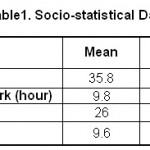 |
Table 1: Socio-statistical Data Click here to View table |
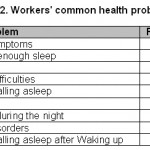 |
Table 2: Workers’ common health problems Click here to View table |
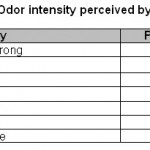 |
Table 3: Odor intensity perceived by workers Click here to View table |
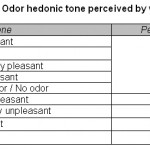 |
Table 4: Odor hedonic tone perceived by workers Click here to View table |
Part 2: Personal Health Status Data
In this part data illustrated that eye irritation (21%) and not getting enough sleep (21%) were equally more common in respondents comparing with other health problems. Data related to this part are briefed in Table2.
Generally 69% of the respondents had at least on of the problems mentioned in the above table. 69% showed no allergy symptoms. 39% of the allergic people had to take medicine. Only 19% of the participants were regular smokers.
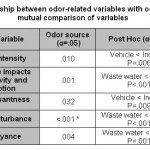 |
Table 5: Relationship between odor-related variables with odor source and mutual comparison of variables Click here to View table |
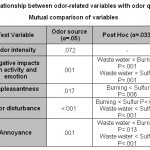 |
Table 6: Relationship between odor-related variables with odor quality and Mutual comparison of variables Click here to View table |
Part 3: Odor Characteristics Sensitivity to Odor
data resulted from this item showed that 98% of the individuals have perceived the odor from the outdoor source in their working places which is known as the industry (Vegetable Oil Manufacturing plant) by 78% of them. Figures 1 and 2 illustrate the odor source and quality. Sulfuric, burning, sweet and wastewater are the options for determining odor quality.
Odor Frequency
6 categories from 1 for once or less monthly to 6 for frequently in a day have been offered for this variable, the last item frequently in a day has been chosen by 91% of the respondents.
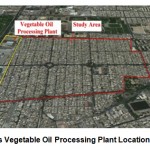 |
Figure 1: Map of Pars Vegetable Oil Processing Plant Location and Study Area Click here to View figure |
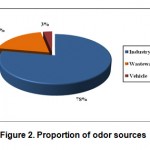 |
Figure 2: Proportion of odor sources Click here to View figure |
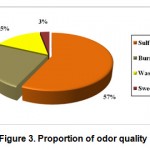 |
Figure 3: Proportion of odor quality Click here to View figure |
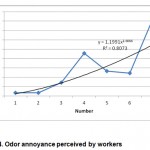 |
Figure 4: Odor annoyance perceived by workers Click here to View figure |
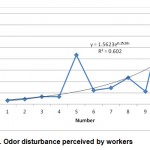 |
Figure 5: Odor disturbance perceived by workers Click here to View figure |
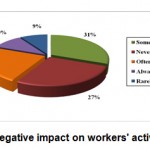 |
Figure 6: Odor negative impact on workers’ activity and emotion Click here to View figure |
Odor Intensity
7 classes from 0 for not perceptible to 6 for unbearably strong have been chosen for determining the intensity of odor, 23% of the workers have mentioned it as distinct and totally 73% have chosen distinct to unbearable options. Results are shown in Table3.
Hedonic Tone
this variable has been divided to 9 classes from -4 for offensive to +4 for very pleasant.
Annoyance
7 scales have been offered in the questionnaire for this variable from 0 for no annoyance to 6 for maximum annoyance, 41% of the respondents have chosen the maximum annoyance item. Nearly 66.6% of the people have answered 4 to 6. The sample annoyance mean has been 4.64 (1.58). The confidence interval for odor annoyance level which has been calculated by non-parametric percentile bootstrapping was 4.6 and 4.2. Figure 3 illustrates the related results.
Disturbance
In order to determine the disturbance level it has been divided to 11 categories from 0 for no disturbance to 10 for maximum disturbance. 37.2% of the respondents have selected number 10 which means maximum disturbance. The mean odor disturbance degree was 7.4 (4.6). The confidence interval for odor disturbance has been calculated by non-parametric percentile bootstrapping which was 7.0 and 7.8. Figure 4 shows the related results.
Odor Acceptability
2 scales have been defined in this part (0 for acceptable and 1 for unacceptable). The results show that 82% of the respondents have known the odor unacceptable, 33% of which have complained to the related authorities.
The statistical relationship between the respondents' adaptability to odor and complaining to the local governors has been calculated by Fisher's Exact 2-sided Test which was significant (p<0.002).
Part 4: Odor Negative Impacts on Workers' Activity and Emotion
Results related to this topic showed that 10% of the respondents have always felt the odor negative effects on their activity and emotion. Figure 5 illustrates the result of this section.
There is a significant relationship between the duration of time spent at work with the evidences these effects. (Spearman r=+0.26 p<0.001). The relationship between record of service and showing these impacts is significant additionally. (Spearman r= +0.34 p< 0.001). Record of service has also significant relationship with odor disturbance and annoyance but no relationship were found with odor intensity.
Spearman correlation coefficients between odor perception intensity, negative impacts on activity and emotion, hedonic tone, disturbance and annoyance show significant relationship among them (p<0.001). The coefficient values are +0.40 to +0.83.
The effect of odor source on its intensity, negative impacts on activity and emotion, unpleasantness, disturbance and annoyance have been studied by Kruskal-Wallis test at first, then different sources have been compared by repeating Mann-Whitney U test and applying Bonferroni correction in order to adjust type 1 error while comparing multiple variables.
According to the results, this industrial source odor and its unpleasantness are significantly more than other sources which were defined in this study.
The role of odor type on the related properties including negative impacts on activity and emotion, unpleasantness, disturbance and annoyance have been also investigated by Kruskal-Wallis test at first, then different sources have been compared by repeating Mann-Whitney U test and applying Bonferroni correction in order to adjust type 1 error while comparing multiple variables.
Odor intensity is not significantly different in defined odor types but sulfur type is more unpleasant, annoying and disturbing than others.
Discussion
The main objective of this research has been assessment of industrial source odor related parameters on non-industrial workers in the region. In many countries investigations about odor pollution have been considered and the impacts of this environmental problem on nearby residents or the employees working in the place which is known as odor source have been studied. Unfortunately there is no research about odor related effects on other workers close by. This group of people is not exposed to odor as long as near residents and also is not intensely in contact with odorous materials like industrial workers, but the result of this study shows that odor pollution is unbearable for 82% of the respondents.
Considering that industry has been recognized as the most important external parameter which affect the quality of working environments, the impact of this plant on decreasing the quality level of working conditions is more obvious.
The duration of presence in the working place and record of service are related to disorders in working activity and motion and thus confirm the odor pollution impacts on the employees' efficiency. The results achieved by Ludvigson et al. (1989) and Wilkinson (2002) have also mentioned this.
According to Winneke and Steinheider in 199336 and also Thuerauf et al. in 2009 [37] gender affects the intensity of odor perception and females feel more level of annoyance. In this study, also average values women have given to annoyance and disturbance levels are more than men (Although due to the insufficient number of women the test is not strong enough).
In this research there is an adverse relationship between age increase with annoyance, the level of which is less in older workers than younger ones. This conclusion is confirmed by the results from Konstantinidis et al (2006), Larsson et al (2009) ,Pierre M. Cavalini and RAJESH KUMAR SINGH researches.38- 41
On the basis of results of this study, more comprehensive investigations about odor pollution management in different fields is recommended. Moreover, effective measures to decrease and control the odor related impacts and providing the citizens' health is emphasized. It should also be mentioned that compliance with the regulations related to industrial positioning and keeping the possible maximum distance from residential area are effective ways of reducing air pollution such as odor and increasing the residents' quality of life.
Considering the lack of comprehensive management systems to decrease the odor pollution and also absence of necessary related regulations in Iran, it is expected that the results of such researches would be an effective factor in making the authorities more sensitive and a motivation to develop comprehensive studies about odor pollution management plan.
References
- McGinley ,C.M, McGinley, M.A, “Field Odor Monitoring and Enforcement”, The 22nd Annual Hawaii Water Environment Association Conference Honolulu, Hawaii:(20000.
- McGinley.C,M, Mahin, T. D., . Pope P.E., R. J, “Elements of Successful Odor / Odor Laws” WEF Odor / VOC 2000 Specialty Conference Cincinnati, OH. 16-19 (2000).
- Zaini Sakawi, Sharifah Mastura S.A., Othman Jaafar and Mastura Mahmud” Sensitive Receivers Responses on Odor Annoyance of a Neighborhood Open Landfill Site” Journal of Applied Sciences in Environmental Sanitation, 6(2): 191-199 (2011).
- Scottish Environment protection agency, “odor Guidance Note”. Operational Quality manual. Guidance on regulating odors Activities. External Consultation Draft 3: 3of 107 (2008).
- Berglund,B.,Hassmen,P.,& Job,R.F. ,”Source and effect of low- frequency noise”, Journal of the Acoustical Society of America, 99: 2985-3002 (1996). http://dx.doi.org/10.1121/1.414863
- Lindvall,T.,” Monitoring odors air pollution in the field with human observes. Annals of the New York Academy of Sciences. 237.242- 260 (1974).
- Response. Iowa State University: Department of Animal Science.
- PM 1963c. The Science of Smell Part 3: Odor detection and measurement. Iowa State University: Department of Animal Science
- Aatamila, M., Verkasalo, P. K., Korjonen, M. J., Suominen, A. L., Hirvonen, M. R.,Viluksela, M. K.And Nevalainen, A., Odor annoyance and physical symtoms residents living near waste treatment centre. Environmental Research 111: 164-170(2011). http://dx.doi.org/10.1016/j.envres.2010.11.008
- Sven Nimmermark,” Odor Impact”, Odor release, dispersion and influence on human well-being with specific focus on animal production, Doctoral thesis, Swedish University of Agricultural Sciences, Alnarp 2004
- WHO: Preamble to the Constitution of the World HealthOrganization as adopted by the International Health Conference, New York, 19-22 June, 1946; signed on 22 July 1946 by the representatives of 61 States (Official Records of the World Health Organization, no. 2, p.
- Susan S. Schiffman,’ Elizabeth A. Saltely Miller, Mark S. Suggs And Brevick G. Graham, The Effect of Environmental Odors Emanating From Commercial Swine Operations on the Mood of Nearby Residents, Brain Research Bulletin, 37(4): 369-375 (1995). http://dx.doi.org/10.1016/0361-9230(95)00015-1
- NCR, “Odors from stationary and Mobile sources”, Washington , D.C. National research Council. (1979).
- Warren D, Walker J, Drake A, Lutz R. Assessing the effects of odorants on nasal airway size and breathing. Physiol Behav 51: 425-430 (1992). http://dx.doi.org/10.1016/0031-9384(92)90161-T
- Ware J, Spengler J, Neas L, Samet J, Wagner G, Coultas D, Ozkaynak H, Schwab M. Respiratory and irritant health effects of ambient volatile organic compounds Am J Epidemiol 137: 1298-1301 (1993).
- Levin A, Byers V. Environmental illness: a disorder of immune regulation. State Art Rev Occup Med 2:669-681 (1987).
- Marshall J, Bienenstock J. The role of mast cells in inflammatory reactions of the airways, skin, and intestine. Curr Opin Immunol 6:853- 859 (1994). http://dx.doi.org/10.1016/0952-7915(94)90004-3
- Manish Kumar Mishra and D.P. Pandey, Orient. J. Chem., 27(1): 305-311 (2011).
- Doty RL, Deems DA, Frye RE, Pelberg R, Shapiro A: Olfactory sensitivity, nasal resistance, and autonomic function in patients with multiple chemical sensitivities. Arch Otolaryngol Head Neck Surg 114(12): 1422-1427 (1988). http://dx.doi.org/10.1001/archotol.1988.01860240072027
- Baron, R.A., Olfaction and human social behavior: Effects of pleasant scents on physical aggression. Basic and Applied Social Psychology 1(2): 163-172 (1980). http://dx.doi.org/10.1207/s15324834basp0102_5
- Benton, D., The influence of androstenol – a putative human pheromone – on mood throughout the menstrual cycle. Biological Psychology 15: 249-256 (1982). http://dx.doi.org/10.1016/0301-0511(82)90047-3
- Baron, R.A., Self-presentation in job interviews: When there can be too much of a good thing. Journal of Applied Social Psychology 16(1): 16-28 (1986). http://dx.doi.org/10.1111/j.1559-1816.1986.tb02275.x
- Baron, R.A., Environmentally-induced positive affect: Its impact on self-efficacy, taskperformance and conflict. Journal of Applied Social Psychology 20(5): 368-384 (1990). http://dx.doi.org/10.1111/j.1559-1816.1990.tb00417.x
- Schiffman, S.S., Ageing and the sense of smell: potential benefits of fragrance enhancement. In Fragrance: The psychology and biology of perfume. Proceedings of the 2nd International Conference on the Psychology of Perfumery, University of Warwick, Coventry, England, Elsevier Applied Science Amsterdam (1991).
- Knasko, S.C. Ambient odors effects on creativity, mood, and perceived health. Chemical Senses 17(1): 27-35 (1992). http://dx.doi.org/10.1093/chemse/17.1.27
- Schiffman, S.S., Sattely-Miller, E.A., Suggs, M.A. & Graham, B.G, Effect of pleasant odors and hormone status on mood of women at midlife. Brain Research Bulletin 36(1): 19-29 (1995a). http://dx.doi.org/10.1016/0361-9230(94)00133-L
- Schiffman, S.S., Suggs, M.S. & Sattelymiller, E.A., Effect of Pleasant Odors on Mood of Males at Midlife - Comparison of African- American and European-American Men. Brain Research Bulletin 36: 31-37 (1995c). Pergamon-Elsevier Science Ltd. http://dx.doi.org/10.1016/0361-9230(94)00134-M
- Martin, G.N., Olfactory remediation: current evidence and possible applications. Social Science and Medicine 43(1): 63-70 (1996). http://dx.doi.org/10.1016/0277-9536(95)00334-7
- Chen, D. & Haviland-Jones, J., Rapid mood change and human odors. Physiology & Behavior 68: 241-250 (1999). http://dx.doi.org/10.1016/S0031-9384(99)00147-X
- Lehrner, J., Eckersberger, C., Walla, P., Pötsch, G. & Deecke, L., Ambient odor of orange in a dental office reduces anxiety and improves mood in female patients. Physiology & Behavior 71: 83-86 (2000). http://dx.doi.org/10.1016/S0031-9384(00)00308-5
- Barker, S., Grayhem, P., Koon, J., Perkins, J., Whalen, A. & Raudenbush, B., Improved performance on clerical tasks associated with administration of peppermint odor. Perceptual and Motor Skills 97: 1007-1010 (2003). http://dx.doi.org/10.2466/pms.2003.97.3.1007
- Ludvigson, H.W. & Rottman, T.R., Effects of ambient odors of lavender and cloves on cognition, memory, affect and mood. Chemical Senses 14(4): 525-536 (1989). http://dx.doi.org/10.1093/chemse/14.4.525
- David Matthew Wilkinson, Indoor air quality management in the office workplace, Presented to the Faculty of the University of Alaska Fairbanks In Partial Fulfillment of the Requirements For the Degree of Master of science, (2002)
- Cole, D., Todd, L. & Wing, S., Concentrated swine feeding operations and public health: A review of occupational and community health effects. Environmental Health Perspectives 108(8): 685-699 (2000).
- Tehran Province Statistical Yearbook,Statistical Center of Iran (2007).
- Sucker,K· Both,R · BischoV,M · Guski,R · Krämer,U · Winneke,G.” Odor frequency and odor annoyance Part II: dose–response associations and their modification by hedonic tone. Int Arch Occup Environ Health, 81: 683-694 (2008). http://dx.doi.org/10.1007/s00420-007-0262-4
- Steinheider,B. Winneke,G. “Industrial odors as environmental stressors: Exposureannoyance associations and their modification by coping, age and perceived health”. Journal of Environmental Psychology.13(4): 353-363 (1993). http://dx.doi.org/10.1016/S0272-4944(05)80257-9
- Thuerauf,N. Reulbacha, U. Lunkenheimera, c, J. Lunkenheimera, B. Spannenbergera, R. Gosslera, A Maihöfnerb,C. Bleicha,S. Kornhubera, d, J. Markovica,K.” Emotional reactivity to odors: Olfactory sensitivity and the span of emotional evaluation separate the genders. Neuroscience Letters. 456(2): Pages 74-79.5 (2009).
- Iordanis Konstantinidis a, Thomas Hummela,”, Maria Larsson, Identification of unpleasant odors is independent of age, Konstantinidis et al., Archives of Clinical Neuropsychology 21: 615-621 (2006). http://dx.doi.org/10.1016/j.acn.2006.05.006
- M. Larsson,a,b* L. Farde,b,c T. Hummel,d M. Witt,d,e N. Erixon Lindroth b,c and l. bäckmanf age-related loss of olfactory sensitivity: association to dopamine transporter binding in putamen, Neuroscience 161: 422-426 (2009). http://dx.doi.org/10.1016/j.neuroscience.2009.03.074
- Pierre M. Cavalini,a Industrial Odorants: The Relationship between Modeled Exposure Concentrations and Annoyance, Journal of Environmental Science and Health, Part A Toxic/Hazardous Substances and Environmental Engineering, 49(5): pages 344-351 (1994).
- Rajesh Kumar Singh, study of effect of Air pollution on wheat, Journal of Current World Environment, 6(6): (2012).






